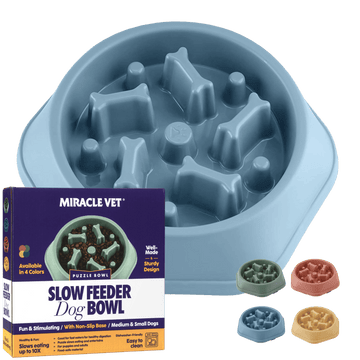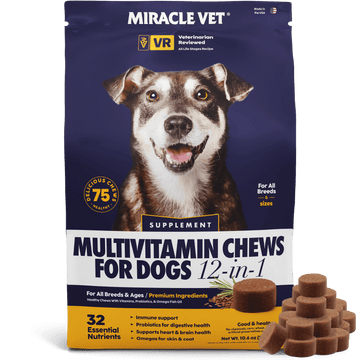-
Regularly checking your dog’s body condition score helps ensure they maintain a healthy body weight and alerts you early if they're becoming underweight.
-
Visible signs, such as a pronounced waist or changes in dog’s appetite and behavior, can be early warnings of weight-related issues.
-
Rapid weight loss in dogs often indicates an underlying health issue like inflammatory bowel disease, kidney disease, or intestinal parasites.
-
Emotional stress, anxiety, and poor nutrition are significant factors preventing your pup from maintaining a healthy dog’s body condition.
-
Effective solutions include customized diets, consistent veterinary care, and using nutritional supplements under expert guidance.
Why Is My Dog Skinny – What Health Problems Can Cause a Canine to Be Thin?
If you’ve recently noticed your pup losing weight and asked yourself, “why is my dog skinny?” you’re not alone. A sudden or gradual drop in body weight can be a sign of a serious condition that needs attention. Canines can lose weight for many reasons—some as simple as a change in routine, others related to underlying health issues.
Common medical causes include parasites, dental disease, diabetes mellitus, metabolic disorders, kidney problems, and types of cancer. If you're wondering, "why is my dog skinny," the best way to get answers is to visit your veterinarian for a full check-up and a tailored treatment plan. Ignoring the issue could lead to worsening health and decreased quality of life for your pet.
In many cases, early intervention can prevent more severe outcomes. That’s why paying close attention to your dog’s body condition score and taking quick action if anything seems off is essential. Early diagnosis allows for more effective treatment and a faster return to a healthy, happy lifestyle.

Identifying the Signs of an Underweight Dog
To determine if your dog is underweight, look for physical and behavioral clues. Pay close attention to their shape, energy levels, and dog’s body condition score. Pet parents who understand what to look for can catch issues early and prevent more serious problems from developing.
Visual and Physical Indicators
One of the most noticeable signs that your dog may be underweight is their appearance. If you can see your dog’s ribs, hip bones, or spine—or if these bones feel overly prominent when you run your hands along their body—your dog may be underweight. Loss of muscle mass, especially around the shoulders and hind legs, is another indication of a poor dog’s body condition.
In healthy canines, you should be able to feel the ribs without pressing too hard, but they should not be visible. A severely tucked-in waist and a bony frame are visual cues that something is wrong. Dogs that are too thin might also seem weaker or less energetic than usual, avoiding physical activities they once enjoyed. These signs, combined with changes in dog’s appetite, signal it's time for a veterinary evaluation.
Behavioral Changes to Watch For
Behavioral changes often go hand-in-hand with physical symptoms. Is your pup eating less than usual? Have they become more lethargic, anxious, or withdrawn? If your dog eats more but continues to lose weight, diabetes mellitus could be the cause, especially if paired with symptoms like increased thirst and urination. This happens due to abnormal blood glucose metabolism.
Behavioral cues such as disinterest in toys, reluctance to go on walks, or even hiding away in quiet areas can all be early signs of trouble. These are the first things you should discuss with your veterinarian, who can recommend a diagnostic plan to identify the issue.
Common Health Issues Leading to Weight Loss in Dogs
If your dog is losing weight for no clear reason, it's time for a comprehensive veterinary check-up. Issues with the intestinal tract, chronic illnesses, and poor nutrition can all contribute to weight loss and reduced vitality.
Digestive Problems and Their Impact
Digestive issues such as inflammatory bowel disease (IBD) and exocrine pancreatic insufficiency interfere with nutrient absorption. This results in rapid weight loss even when your pup is eating a normal amount of food. These conditions affect the intestinal tract, limiting the body’s ability to process and absorb key nutrients.
Your veterinarian may recommend stool tests or an abdominal ultrasound to help diagnose the issue. Managing these conditions typically involves feeding your dog highly digestible, quality dog food along with prescribed medications to reduce inflammation and support digestion. These diets should include ingredients that are easy on the stomach, rich in protein, and low in fat.
Chronic Diseases That Affect Weight
Long-term conditions like kidney disease, types of cancer, and diabetes mellitus can significantly impact your dog’s body weight. Kidney issues often lead to nausea and reduced appetite. Diabetes mellitus is another major cause, where the canine may eat excessively yet still lose weight due to poor blood sugar regulation.
Some types of cancer, especially those that affect the gastrointestinal system, make it hard for the canine to digest food properly. Others drain energy by using excess calories to grow tumors. For senior dogs and older dogs, routine bloodwork and physical exams are vital to catch these illnesses early. Additional testing is often required to make a proper diagnosis.

Nutritional Factors Contributing to a Dog's Low Weight
Nutrition plays a crucial role in maintaining a healthy dog’s body condition score. Feeding poor-quality or improperly balanced food can lead to long-term health complications and weight loss.
Evaluating Your Dog’s Diet
Ensuring your canine receives the right amount of food each day is crucial. This should be tailored based on their age, size, breed, and activity level. Wet food or specially formulated dog foods for weight gain may be appropriate, especially if your dog has a poor appetite.
Look for quality dog food with real animal proteins, healthy fats, and complex carbohydrates. Simply increasing food quantity isn’t always effective if the nutritional content is lacking. Consulting a veterinary nutritionist can be a good idea when creating a customized feeding plan.
The Role of Malnutrition and Poor Absorption
Even when canines are fed well, they can become malnourished if their bodies don’t absorb nutrients properly. This often occurs in dogs with chronic digestive issues. Poor absorption leads to weight loss, muscle depletion, and weakened immunity.
Malnutrition is more than just being thin—it reflects a state where the body is starved of essential nutrients, despite food intake. Providing nutrient-dense meals, along with treatments that support digestion, is essential for helping your dog recover.
Psychological Causes of Weight Loss in Dogs
Mental health can have a surprising impact on your dog’s physical condition. Anxiety, stress, and behavioral disorders can lead to decreased dog’s appetite and eventual weight loss.
Stress and Anxiety Effects
Dogs can develop anxiety from separation, loud noises, or major life changes. Dog parents may notice signs like excessive pacing, whining, or lack of interest in food. Stress burns calories quickly and, if unaddressed, can cause significant body weight loss.
Creating a calm environment, keeping routines consistent, and using vet-approved calming supplements can help ease anxiety and restore a healthy dog’s body condition.
The Impact of Environmental Changes
Changes like moving, travel, or introducing a new pet can be stressful for canines. These changes may result in reduced food intake and rapid weight loss. Reassure your pup by maintaining consistent feeding times and creating a predictable daily routine. Keep an eye on their weight and behavior. For ongoing issues, consult your vet for further guidance.

Effective Strategies for Helping Your Dog Gain Weight
Helping a skinny dog return to a healthy body condition takes time, care, and consistency. Nutrition, exercise, and medical treatment all play important roles.
Choosing the Right Diet for Weight Gain
Select foods designed to support weight gain. These should be rich in calories, protein, and healthy fats. Options include high-protein wet food, puppy formulas, or veterinary-recommended diets.
|
Nutritional Focus |
Examples |
|---|---|
|
High-calorie ingredients |
Chicken, peanut butter, fish oil |
|
Nutritional supplements |
Omega fatty acids, vitamins |
|
Balanced diet components |
Real meat proteins, complex carbs |
You can also add calorie boosters to meals, such as bone broth or lean cooked meats. Just ensure any changes align with your vet’s recommendations.
The Importance of Regular Veterinary Consultations
Regular check-ins with your vet help track your dog’s progress and adjust the treatment plan as needed. Vets may use additional testing like abdominal ultrasound or blood sugar tests to ensure nothing is being overlooked.
Routine monitoring is especially important for senior dogs, who may face more challenges maintaining weight. A tailored plan ensures your dog gains weight safely and remains healthy long-term.
Conclusion
Understanding why your dog is losing weight—whether from medical, emotional, or dietary causes—is crucial for helping them regain strength and health. If you find yourself asking, “why is my dog skinny?” take it as a prompt to act.
By working with your veterinarian to identify the root cause and implement a personalized treatment plan, you’ll give your pup the best chance at recovery. Whether it's improving their diet, managing a chronic illness, or reducing stress, every step brings your pup closer to becoming the healthy dog they’re meant to be.
Need support for your dog’s weight concerns? Schedule a wellness check or speak with our team of veterinary nutrition experts today.
Frequently Asked Questions
What is a healthy weight range for dogs?
A healthy weight is different for every dog. It depends on the dog's breed, age, and size. You should be able to see a waist when looking at your dog from above. You should also be able to feel the ribs, but they should not stick out. If you are not sure, talk to your veterinarian. They can tell you a healthy weight for your dog's breed. This helps keep your dog in the best health.
How often should I feed my underweight dog?
Feed your underweight dog two or three times daily. Make sure that each meal has good-quality, calorie-dense food. Find the right portion for your dog and change it if needed. You should check their body mass often to help them get a healthy weight. For tips that fit your dog, talk to your vet. This helps support your dog's healthy weight and weight gain.
How can I determine if my dog's diet suits their needs?
To see if your dog’s diet is good, watch their body mass and how much energy they have. Look at the condition of their coat, too. Talk to a veterinarian for advice that fits your dog’s age, size, and activity level. Check how much food you give and what is in it often. This helps you make sure your dog gets good nutrition.
What common health issues can cause a dog to be underweight?
Some health problems can cause a dog to be underweight. Long-term diseases like cancer or kidney disease are the leading causes. Problems with the thyroid can also affect how your dog’s body handles food. Also, stomach or gut problems make it hard for dogs to take in the nutrients they need. On top of that, stress and anxiety are other reasons why a dog might have weight loss.
What are the best types of food to help a skinny dog gain weight safely?
High-quality foods with more calories can help a skinny dog gain weight. Puppy formulas, wet dog food, and meals for weight gain are good choices. You can also add healthy fats like fish oil and chicken fat. These give the dog essential nutrients and help them want to eat more.











